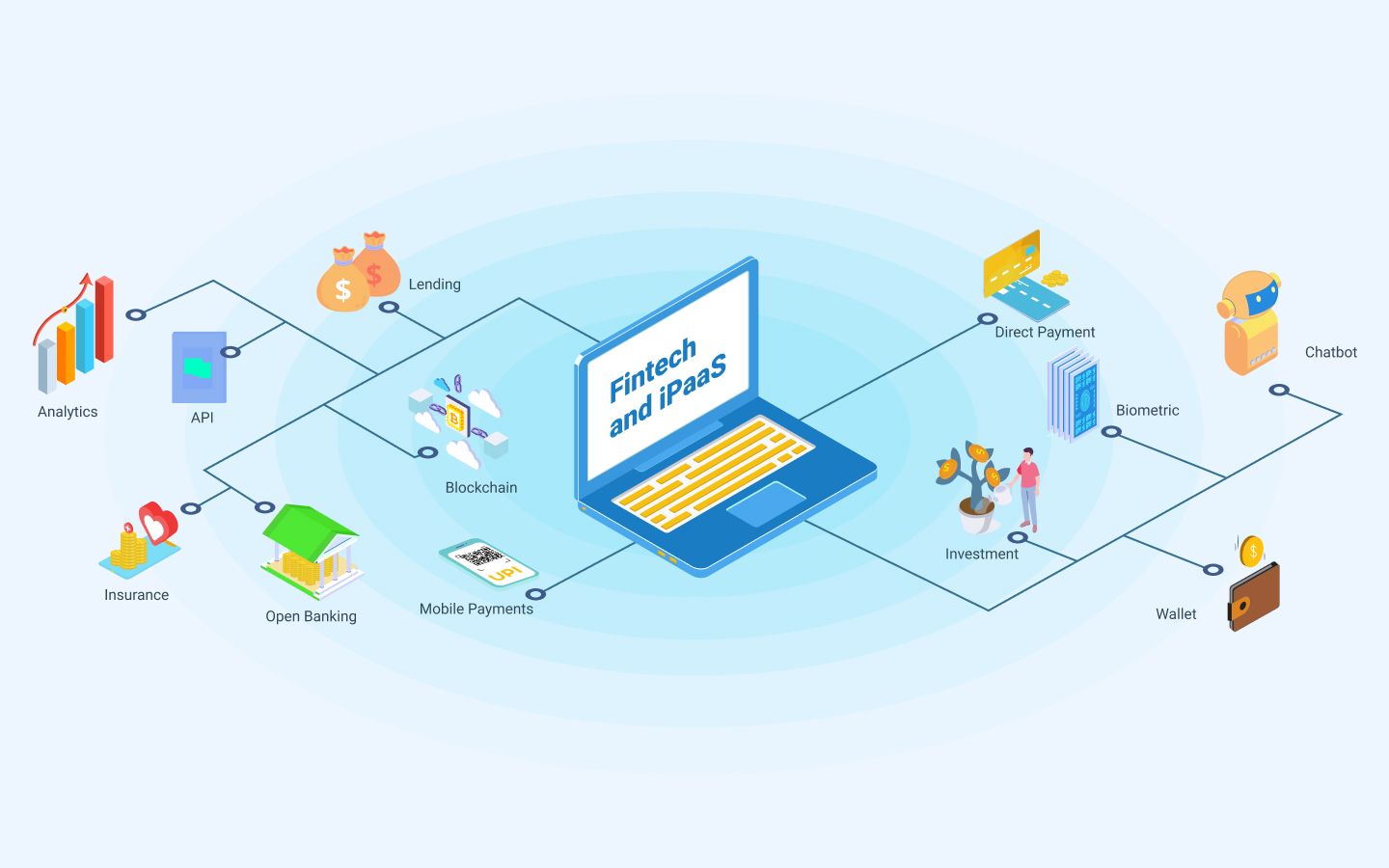Cloud services are gaining traction across the globe. A significant reason for this is the shift from traditional IT infrastructure to software-as-a-service (SaaS). In fact, 58% of the global population uses cloud products and this trend will continue, and it's going to lead to more widespread usage of FinTech solutions.
FinTech is an industry that has grown rapidly over the last few years and one that has a bright future ahead of it.
In this article, we will do a thorough walkthrough of:
- What is FinTech?
- APIs in FinTech
- Benefits of APIs
- FinTech Examples/Use Cases
- Leverage the power of APIs with Quickwork
- Conclusion
What is FinTech?
“Fin= Financial, Tech= Technology”
FinTech is a relatively new and often abstract term that applies to any evolving technology that can help consumers and businesses receive financial services faster, more efficient ways than was traditionally available.
Financial technology (FinTech) is a category of new technologies that seek to improve and automate the delivery and use of financial products and services. FinTech is a rapidly growing industry with applications that run across sectors, including consumer banking, wealth management, insurance, investment banking, payment systems, peer-to-peer lending, and more. FinTech offers new solutions in personal finance that can dramatically improve users' lives and save businesses time and money.
For example, Think about the difference between going into a bank to check your balance and having that information presented on your phone — just like checking your email. These are two of the most significant inventions in the financial sector history. Are you aware of the ways your bank can benefit you?
Everything from the ability to see financial transactions online to apps that let you pay people to tools that let banks make quick lending decisions is all part of the evolution of financial services.
Related: FinTech revolution: Open Banking with APIs & iPaaS
Now we know what FinTech is, let’s understand the backbone that enables these FinTechs?
Application programming interface
Simply put, Application Programming Interface (API) is the code that allows two applications to communicate with each other. It’s a way for you to connect to apps and services you use daily. For example, when you use Facebook, send an email, or check the weather, you’re using an API.
Read more about APIs here: What is application integration and how to achieve enterprise-level efficiency
The banking and finance industry has seen disruptive growth in the last few years. Two of the significant factors that have driven this change and growth in the last few years have been the rise of financial technology companies and APIs. Because of this, individuals are able to manage their finances from anywhere they wish with no interaction with a bank.
The rise of open banking enabled by APIs has made third-party providers more ubiquitous in the industry. This has led to the development of a variety of FinTech apps and programs, making financial lives better by simplifying the way people manage their money.
APIs in FinTech
Financial technology refers to the new breed of companies that provide financial services and products through the use of high-tech, computer-based systems. The FinTech sector is one of the most rapidly growing tech sectors, offering a wide range of financial services and products through innovative digital platforms.
An API is a program that lets other programs talk to each other. For example, an API allows a FinTech program to interact with a financial institution’s server. APIs are the technological means by which FinTech and financial services communicate with each other. Using APIs, programs can access information from one another and make transactions or make modifications.
Benefits of APIs
Cost-Effective:
APIs help to tailor a client's experience, saving banks money in the long run and helping their customers. Instead of being stuck with a boring, over-simplified platform, banking customers can customize their services exactly to their needs.
Thanks to the use of APIs, banks are able to provide customers with even more services. One example is the integration of bank accounts with software that allows customers to manage their finances in one place.
Data Accessibility:
Before the introduction of PSD2 in 2016, banks could keep their data and information hidden from the public. Keeping the data and information locked away was seen as a good thing, but it made it hard for programs and users to access the valuable data they need. PSD2 makes financial data accessible to third parties.
The right to manage or access one's data has always been a core property of the digital age, and it is the foundation of both the GDPR and PSD2. In this new era of intelligent automation, we can now use our mobile phones to control all aspects of our lives.
The new EU regulation will make users even more aware of what is going on with their data. Users will now have the legal right to know how their personal information is used. Before, users had to trust a company not to misuse their data. Now, they can let companies know if they want to continue to use their information.
Growth-led
The number of financial technology APIs has increased dramatically in recent years, helping to provide a wide variety of financial data for use in FinTech applications. The continued growth and development have meant that financial technology is becoming more and more robust. It will continue to develop and grow into the future.
FinTech Use Cases
Though the tech industry is associated with disruptive technology and startups, big businesses and banks are also using the same FinTech services. Here's a quick look at a few FinTech examples and how the industry is using these same technologies to enhance their existing business strategies and disrupt how they do things in the future.
Banking:
Mobile banking has become an important part of the financial services industry. With the spread of neobanks such as GoCardless and Revolut, many banks are offering mobile-friendly banking features. These features attract a diverse customer base, making it easier for consumers to manage their finances.
Neobanks are essentially mobile-optimized banks, offering a variety of banking services on their web and app-only platforms. They operate without the need for physical branch locations or brick-and-mortar offices. From personal checking accounts to money transfers, loans to savings accounts, these banks have it all. Some of the more popular neobanks include Chime, Simple, and Varo.
Cryptocurrency & Blockchain:
The crypto-currency phenomenon is a new kind of financial innovation that will allow us to rethink the way we engage with money, with money transforming into data. Blockchain, the technology upon which cryptocurrency is built, is a new kind of database that can be used to store and share information. Both of these are considered outside the realm of FinTech, but they are increasingly working together as complementary solutions for consumers.
Investment & Savings:
FinTech has caused a revolution in investing. The barriers to investing are falling as more and more easy-to-use apps are made available to consumers. With hundreds of apps on the market, this booming industry is making it easier than ever for consumers to invest their money. One of the most popular and best-known apps is Robinhood, which makes it incredibly easy for anyone to invest their money and learn about the markets.
Trading:
The evolution of financial technology has seen the rise of Artificial Intelligence technologies that can extract financial insights from massive datasets. By using advanced natural language processing, these technologies allow traders and investors to gain meaningful insights in a matter of seconds.
Payments:
FinTech is a fast-growing, high-growth industry which has increased competition and disruption in the payments space. FinTech companies are changing the way companies interact with each other in the form of payments in real-time. It's now easier than ever to send money across the world by simply hitting a button on your smartphone. Companies like PayPal, Venmo, Square, and Stripe are changing the way we pay, and money moves around the world.
Lending:
FinTech is revolutionizing the way that consumers obtain loans. The technology allows us to personalize the loan process and tailor it to each individual based on factors such as income, credit history, and location. This makes it much easier for people to borrow money and dramatically increases access to credit in underserved populations.
Additionally, consumers can request their credit reports multiple times a year. In doing this, it is possible to monitor the health of your credit over time. This can be helpful when it comes to managing credit and making better decisions about the kind of loans or other types of financial products that would be best for you. This is a great benefit because you could save money by not applying for the same loan repeatedly.
Insurance:
Insurance is often a late adopter of new technology. However, this is changing as InsurTech companies — which are basically startups that provide insurance to the people — are partnering with insurance companies to expand their coverage areas and automate processes. Companies such as Lemonade Insurance (which covers wearable devices) and PolicyBot (which helps collect quotes from insurance companies in exchange for a fee) are leading the way for the industry’s future.
Related: How Banks & Financial Institutes Can Benefit From iPaaS
Leverage the power of APIs with Quickwork
Quickwork is a leading innovation hub for financial companies. We offer solutions to help our clients solve their most challenging product development challenges. Our team of technology, product and engineering experts provide the expertise needed to turn innovative ideas into successful products and services.
The Quickwork API platform provides a code-free way to develop FinTech applications for finance and banking. It is easy to use, and its cloud-based approach allows businesses to get up and running quickly. Quickwork's APIs are designed for security, and the platform's REST architecture provides unparalleled flexibility.
Conclusion
The growth of FinTech is a sign that traditional financial institutions have finally understood the concept of customer service. In the past, these companies were too slow to act on consumer demand and as a result, found it difficult to continue growing. Now with the rise of FinTech, customers are no longer expecting the same old services from companies. Fast and responsive consumer service has become essential for any company seeking to survive in this new marketplace.
Additionally, financial solutions are no longer set in stone. There are now so many tailored financial products available that customers can choose whichever best suits their needs.
FinTech companies are increasingly able to provide narrow, tailored services that meet particular customer needs. For example, a consumer may need a high-rate savings account where funds are invested in the stock market. Or they may need to borrow money from a peer-to-peer lender of less-than-perfect credit. FinTech companies will fill this need at a much lower cost than traditional banks or lenders.
Read and learn more about FinTech, Open Banking, InsureTech and How iPaaS fits into all this.








